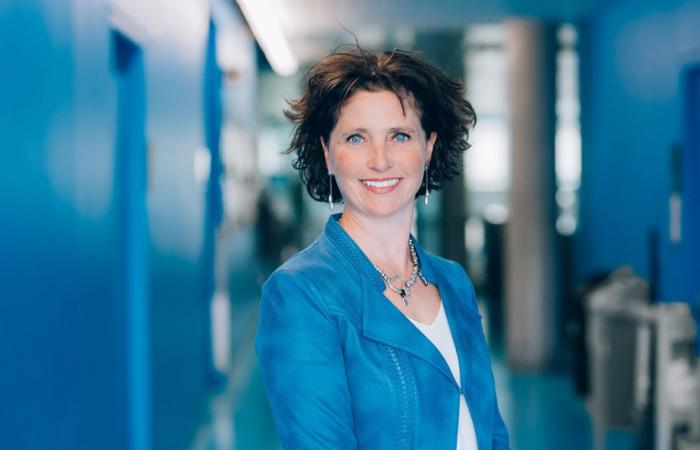(Quebec) The need to build, with billions of dollars, a third highway link between Quebec and Lévis is far from having been demonstrated, according to five experts consulted Monday by The Canadian Press.
Posted at 1:58 p.m.
Updated at 7:52 p.m.
Caroline Plante
The Canadian Press
After several procrastinations, Prime Minister François Legault announced last Thursday that he was relaunching his project for a third highway link, even though the Caisse de dépôt et placement du Québec advises against it.
He spoke of “economic security”; according to him, the Quebec region needs another bridge to the east, near Île d’Orléans, to ensure the transport of goods by truck in the event that the Pierre-Laporte bridge closes.
Catherine Morency, Department of Civil, Geological and Mining Engineering at Polytechnique Montréal
This argument “comes out of nowhere,” laments Professor Catherine Morency of the Department of Civil, Geological and Mining Engineering at Polytechnique Montréal in an interview.
PHOTO PROVIDED BY CAROLINE PERRON, LA PRESSE ARCHIVES
Catherine Morency from the Department of Civil, Geological and Mining Engineering at Polytechnique Montréal
“One, it comes out of nowhere, […] and two, if we want to ensure the feasibility of transporting our goods, it is not the truck that should be our plan A,” she maintains.
“The future is not around heavy trucks for long distance; we need to transfer to rail and maritime,” which have a smaller carbon footprint, according to her.
The Legault government “does not rely on analyses”, denounces Mme Morency.
“It is extremely worrying – it is even odious – that a project of this magnitude, that we decide to launch it like that without anything, any justification, nothing. It’s getting wacky.
“My “job” is not to try to contribute to continually clarifying the enormities that are being said. I’m a teacher, I’m supposed to do research and train people.
“But it’s because there comes a time when it’s so absurd that we say to ourselves: ‘Come on, we can’t let something as stupid as that go by,’” she adds.
The trained engineer asks the government to plan for the future.
In 10-15 years, we will say: “Wow, we were really visionary. We built a third highway link, then we invested all our money, then we wasted all our energy running tanks and trucks.
Catherine Morency
“Is this really our understanding of the global issue? »
Jean Dubé, Graduate School of Land Planning and Regional Development at Laval University
Professor Jean Dubé, from the Graduate School of Territorial Planning and Regional Development at Laval University, also deplores that “the need is not even documented”.
“I’m less than convinced that it’s a good idea. […] I can’t explain where their stubbornness comes from,” he said in an interview, saying he advocated carrying out a rigorous cost-benefit analysis.
Urban sprawl has a significant economic cost dimension that must be borne by society. The list of these costs must also be part of the evaluations.
Jean Dube
“It’s not just the cost of creating an infrastructure, but what are the direct and indirect consequences that this action can bring? This is what is important to study,” he emphasizes.
Jérôme Laviolette, doctoral student in transport engineering within the Mobility Chair at Polytechnique Montréal
A third link that “favors the automobile” will actually lead to urban sprawl, which will not reduce congestion in the long term and will not encourage the use of public transportation, warns Jérôme Laviolette.
According to the doctoral student in transport engineering within the Mobility Chair at Polytechnique Montréal, the Legault government is trying to “justify the unjustifiable”.
The data is not there to justify a third link.
Jerome Laviolette
The government is going “against what we should be doing […] for the development of our cities, for the fight against climate change and for the reduction of social inequalities,” according to him.
Martin Trépanier, Department of Mathematics and Industrial Engineering at Polytechnique Montréal
The important thing, according to Professor Martin Trépanier, of the Department of Mathematics and Industrial Engineering at Polytechnique Montréal, is to properly maintain existing infrastructure, such as the Pierre-Laporte bridge.
“It sends a strange message to say: ‘Look, for safety’s sake, we’re building another one.’ What does that mean, the first one will fall? » he points out.
Furthermore, “all studies say that adding a bridge, which is a road, will ultimately lead to more congestion, more inconvenience.
I know this is extremely counterintuitive. There was a lot of debate on this in the 1970s. Now, there are no longer any real debates among transport planning specialists.
Martin Trépanier
“It is undeniable that adding new infrastructure adds induced demand, therefore adds more traffic, which means that after a few years, the axis will be congested,” he maintains.
In the context where “we must try to reduce the use of the private car as much as possible”, a third link is simply not “compatible with the societal objectives that we should have”, according to him.
Marie-Hélène Vandersmissen, Department of Geography at Laval University
There is “good unanimity” against the third link among experts, says the director of the Department of Geography at Laval University, Marie-Hélène Vandersmissen.
But the Legault government “doesn’t necessarily want to” hear them “because it doesn’t suit them,” she laments in an interview.
Categorical, Mme Vandersmissen says “there is no justification” for a third link.
It would really take very solid economic justifications, figures, data, even if the government does not seem to want them.
Marie-Hélène Vandersmissen
“It seems to me that it is difficult to commit all of Quebec to such an enormous expense without any reflection, any basis of convincing, empirical data,” she said.
The expert says she wants to “raise awareness among the population” about the possible impacts of a third link: urban sprawl, environmental problems, occupation of agricultural land, scars on the landscape, etc.
“There are a lot of problems that come with that that are never considered,” she denounces.
She also claims to have been “taken by surprise” by the “economic security” argument.
“It’s a funny argument to duplicate a large infrastructure just in case. The Pierre-Laporte bridge has never been closed for a very long period,” she emphasizes.
“We are not building a second airport in Quebec in case the first one collapses. It’s a bit special. »







